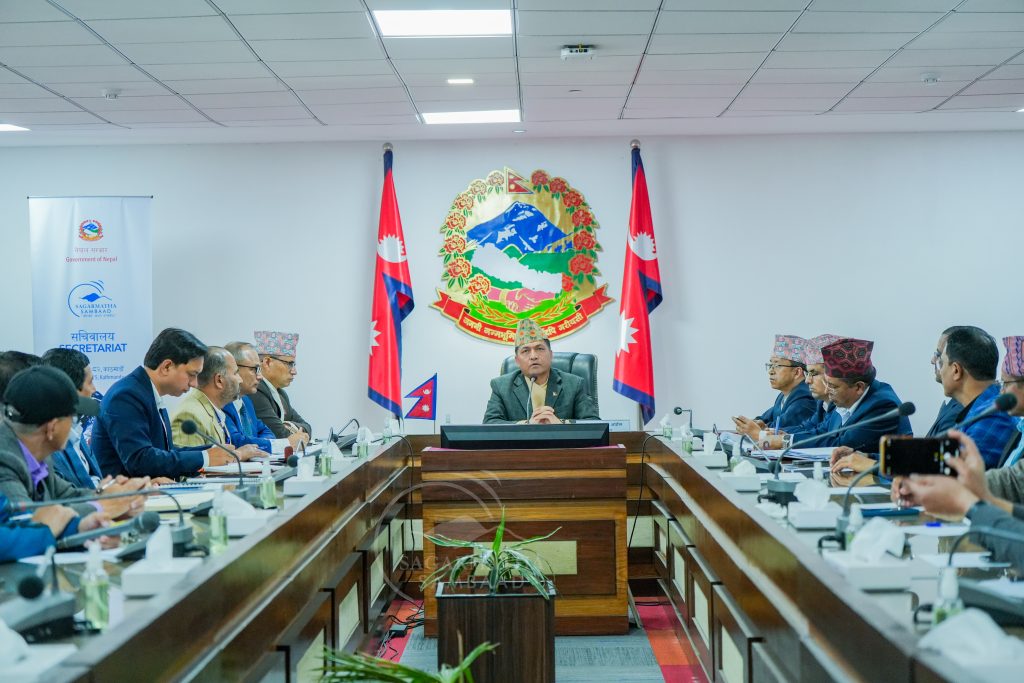43.53 trillion (NDC) action plan approved

Kathmandu - The government has approved the action plan of the second National Determined Contribution (NDC) of Nepal. The action plan estimated to cost around 43.53 billion rupees to implement the NDC by 2030 was approved by the Council of Ministers meeting on Thursday. Nepal will prioritize grant-based international public finance for NDC implementation. Arrangements have been made for the implementation of NDC from international as well as national public and private financial sources.
In this plan, the monitoring indicators, timelines and necessary resources of the actionable activities for achieving the various sectoral and sub-sectoral goals of NDC have been mentioned. The NDC has identified quantitative and policy mitigation targets as well as adaptation priorities. In the NDC prepared in conjunction with the Ministry of Forestry and Environment, there is a commitment to reduce greenhouse gas emissions and adapt to the changing climate. All countries should make such a commitment according to the Paris Agreement.
With the approval of the NDC implementation plan, the roles and responsibilities of the relevant bodies and stakeholders will be clarified and the implementation will be easier and will help in raising international climate finance. Buddhi Poudel said. The action plan aims to increase the production of clean energy from about 1,400 MW to 15,000 MW by the year 2030. 5-10 percent of which will be small and small hydropower, solar, wind and biological energy. Of this, 5,000 MW will be produced from internal sources and the remaining part will depend on the financial support of the international community.
Wisdom was given by Paudel. According to the target, by the year 2030, 15 percent of the total energy demand will be supplied from clean energy sources. Similarly, in 2025, electric vehicles will account for 25 percent of the sales of two-wheeled and four-wheeled private vehicles. Electric rickshaws and electric tempos are not included in the sales target of public vehicles, where the sales share of electric public vehicles is 20 percent of the total public vehicle sales. By the year 2030, 90 percent of the sales of two-wheeled and all four-wheeled private vehicles and 60 percent of the sales of four-wheeled public vehicles will be electric vehicles (electric rickshaws and electric tempos are not included in the target for public vehicles). 200 km by 2030 to support public transport and goods transportation.
Developing a long electric rail network. By 2030, electric vehicle sales will increase to 90 percent of all private vehicle sales (including two-wheelers) and 60 percent of all four-wheeled public passenger vehicle sales (except electric rickshaws and electric three-wheelers). By 2030, 200 km of electric rail network will be developed to support public transport and goods transportation. By the year 2030, 25 percent of the households will mainly use electric stoves for cooking in the action plan. By 2025, the target is to install 500,000 improved stoves, especially in rural areas. By the year 2025, there is a plan to install biogas plants in 200,000 more households and 500 large-scale biogas plants at institutional, industrial, municipal, and community levels. Similarly, by the year 2030, the target has been set to increase the forest area by 4 percent. After which 45 percent of the total area will be forested. By the year 2030, with the financial support of the Red Plus activities, 50 percent of the Terai and Inner Madhes and 25 percent of the forest area in the middle and highland areas have been targeted for sustainable management. By the year 2025, the target is to treat and dispose of 380 million liters of wastewater per day.
There is a plan to manage human excreta waste at the rate of 60,000 cubic meters per year. In the second NDC, the policy goals of the sectors including agriculture, industrial processes and use of manufactured goods, urban settlements and tourism are also included. Nepal has identified 169 goals and 479 indicators in the field of economic, social and environmental development to achieve the goals of sustainable development by 2030. The action plan for the energy sector is focused on clean and renewable energy, especially to transform the energy system of the cooking and transportation sectors from fossil fuels to clean energy.
The action plan of the transport sub-sector focuses on the conversion of public and private sector transport to zero emissions. Special programs include promotion and operation of electric vehicles, implementation of electric bus rapid transit system (EBRT) and expansion of charging infrastructure and stations including rapid charging. Agriculture, Forestry and Other Land Uses: Under Agriculture, Forestry and Other Land Uses, the action plan of the agricultural sector focuses on strengthening the agricultural system by increasing production and productivity while minimizing the contribution of agriculture to greenhouse gas emissions.
The action plan of the forest sub-sector focuses on sustainable and inclusive management of forests and ecosystems, prevention of deforestation and degradation of forests and ecosystems, carbon processing capacity, prosperity of watersheds and wetlands, and ensuring fair and equitable distribution of benefits from forest management. It includes increasing and augmenting forest area, reducing forest destruction to zero, forest fire control, sustainable forest management.

 Pitambar Sigdel
Pitambar Sigdel



Feedback